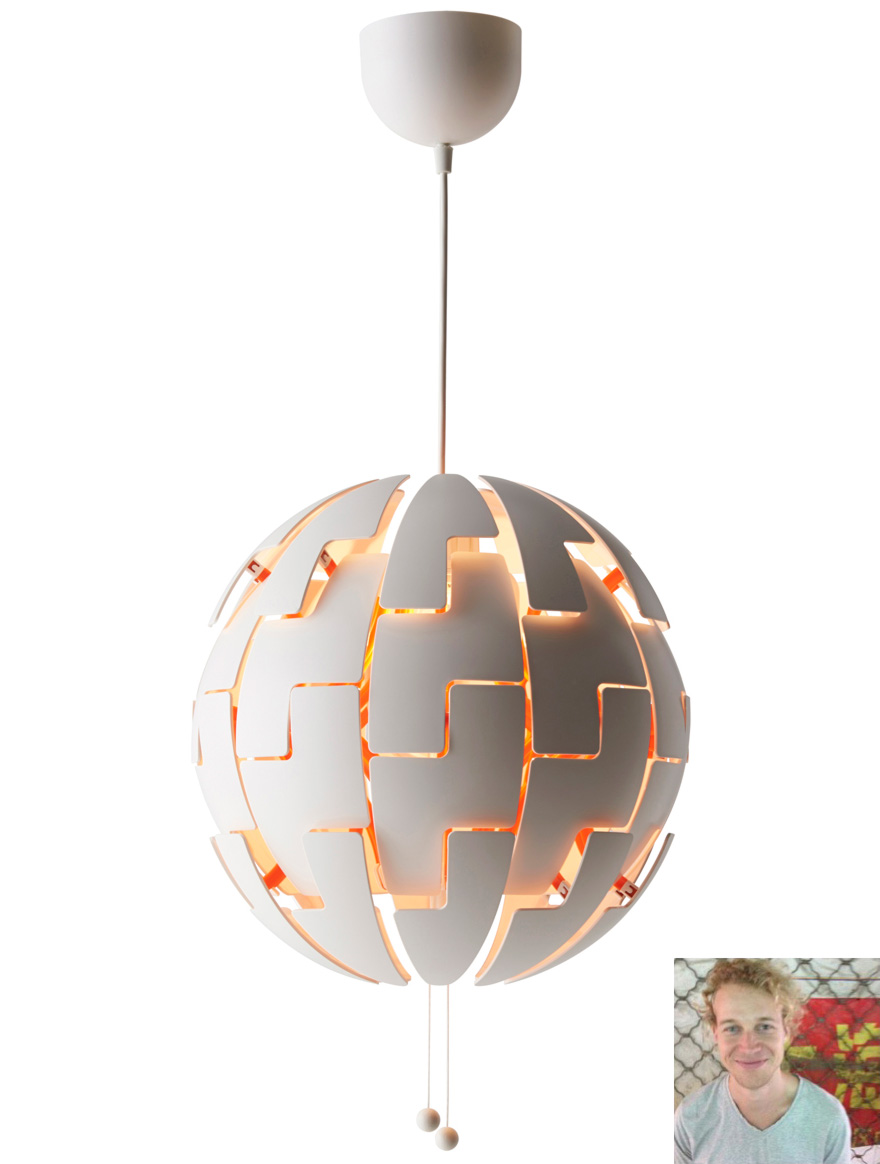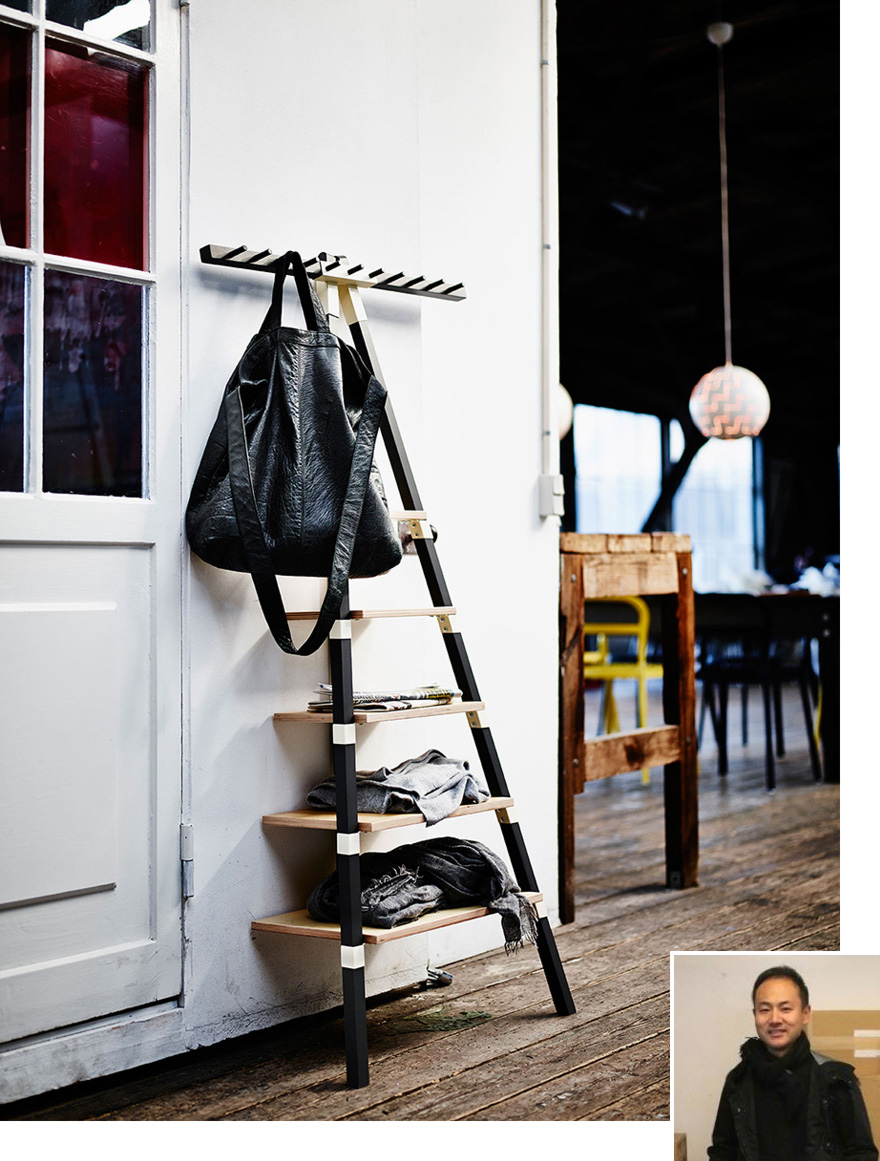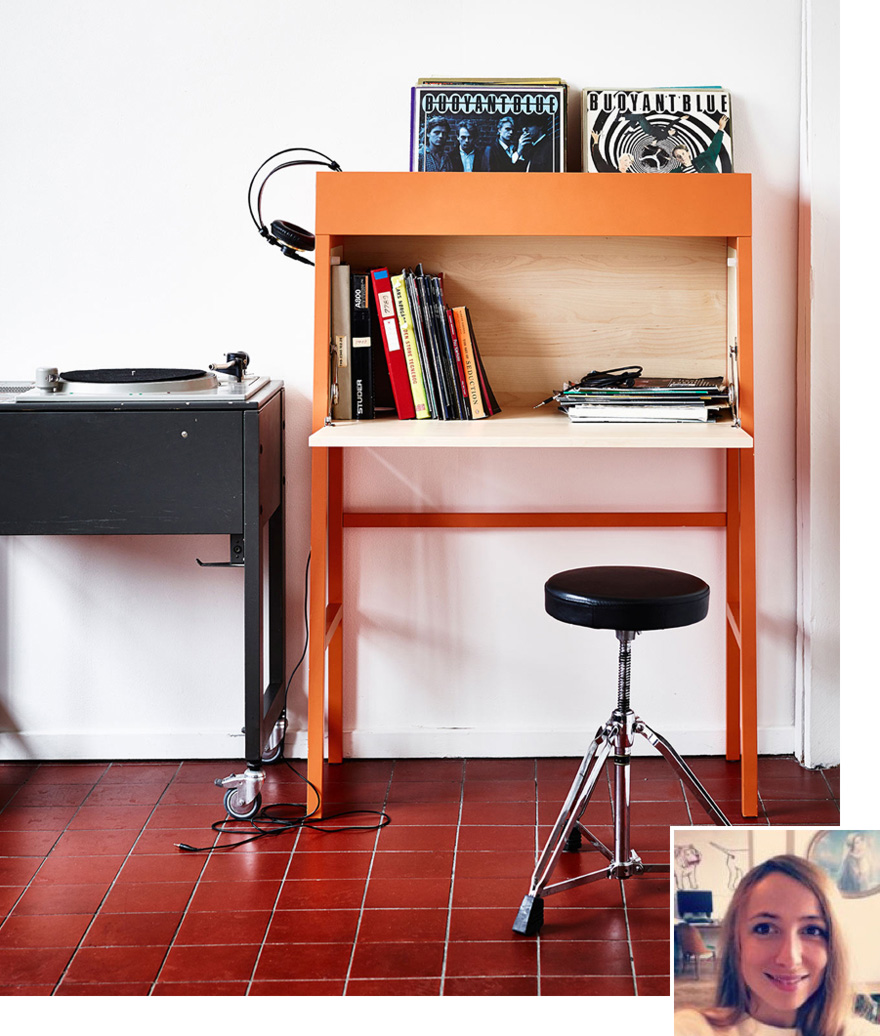Q&A with Six Young Designers Behind IKEA's 2014 PS Collection

While we all know IKEA, it's rare that we actually get to hear from any of their designers. So we were excited to receive some extended Q&As with not one, but a half-dozen of the designers behind their forthcoming PS 2014 Collection.
If you've ever wondered what it's like to design for IKEA, or how these guys and gals arrived there, read on. (Please note that in the following interviews, the designers are apparently referring to the "Secretary" and the "Bureau" as if they are two different names for the same piece; it's possible that was not worked out at press time.)

Designer: David Wahl
Products: - IKEA PS 2014 Pendant Lamp - IKEA PS 2014 Work Station - IKEA PS 2014 Plant Stand
What is your background as a designer? I have been working for IKEA as an in house designer for 3.5 years. Previously I worked as an industrial designer in Stockholm, and before that I graduated from Beckmans College of Design in 2008. Now I am working as a designer for IKEA PDC in Shanghai.
How did you get to work with IKEA PS 2014? I participated in the startup workshop together with the other designers in 2011.
In the process of co-creation, as with IKEA PS 2014, what are the challenges and what are the benefits with working like this? It is fun and creative to meet other designers and see how they work and think. The difficulties are to continue working on the products after the workshop, when everyone is stationed at different locations around the world.
What is your personal experience of moving and living in small spaces? My flat in Sweden is around 25 square meters; it takes a bit of extra effort to furnish in an efficient way. I use a projector for watching movies, instead of a TV. It is small and easy to move with you, and all you need at home is a white wall.
What was your design inspiration for IKEA PS 2014? What was it you wanted to achieve or complete with your design? The inspiration for the Pendant lamp came from science fiction and video games. I also wanted the customer to be able to change the shape of the shade.
How does your design relate to "small space" or "on the move?" I wanted the products to be small enough to fit my own apartment; by doing that I know that other people with limited space can use them as well.
How do you think that your products will be used by people? I hope that people will find new ways of using the products, and that they will customize them to fit their personal style.
What are you most proud of, or like the most, with IKEA PS 2014? The pendant lamp.
Is there anything from the collection you would like to get for yourself? I like the open metal wardrobe.
What are you still waiting for to design? A time machine.

Designer: Keiji Ashizawa Product: IKEA PS 2014 Corner Shelf with Knobs
What is your background as a designer? Prior to forming my architectural practice six years ago, I was a partner and fabricator in a steel workshop. The knowledge and experience I gained over these two years frequently serves as a valuable reference for both my product and architectural work.
How did you get to work with IKEA PS 2014? I received an email from IKEA out of the blue. At first I thought it was just an email from the members' newsletter/mailing list!
In the process of co-creation, as with IKEA PS 2014, what are the challenges and what are the benefits with working like this? I am able to learn a range of different things and share unique ideas with others.
What is your personal experience of moving and living in small spaces? In small spaces, I find that I am continually having to organize things and use spaces in a multitude of ways.
What was your design inspiration for IKEA PS 2014? What was it you wanted to achieve or complete with your design? Inspiration came from my living and office environments which are both small. I would like my designs to be used in a variety of ways and in many places - organisation can be found even in small spaces.
How does your design relate to "small space" or "on the move?" Even small spaces have under-utilised/dead space—I wanted to create designs which make use and give appreciation to such spaces.
How do you think that your product(s) will be used by people? I hope they help people further enjoy small spaces.
What are you most proud of, or like the most, with IKEA?PS2014? That I could have the chance to design products to help people enjoy small spaces, at an accessible price point.
Is there anything from the collection you would like to get for yourself? Yes, so many things for my house and office.
What are you still waiting for to design? I would like to explore and develop concepts which broaden the meaning and versatility of the product.

Designer: Krystian Kowalski Products: - IKEA PS 2014 Secretary - IKEA PS 2014 Corner Cabinet
What is your background as a designer? I am a product and furniture designer graduated from Design Products Royal College of Art.
How did you get to work with IKEA PS 2014? I was invited to take part in co-creation workshop that took place in 2010 in Älmhult. Since then I was developing few ideas for IKEA PS collection.
In the process of co-creation, as with IKEA PS 2014, what are the challenges and what are the benefits with working like this? Personally I think working in team is the most creative and effective process of creation. The challenge is to establish a platform for collaboration for all stakeholders.
What is your personal experience of moving and living in small spaces? Having experience of living and moving from different cities around Europa, I've become a nomad person. This means having only what I can easy take with me to the new place.
What was your design inspiration for IKEA PS 2014? What was it you wanted to achieve or complete with your design? The team I was working with realizes that we share the same need of having small office at home. The idea is to have a work environment within the living space.
How does your design relate to "small space" or "on the move?" It is design to take as little space as necessary yet it is comfortable and functional. The important aspect is that it's easy to combine with different furniture.
How do you think that your product(s) will be used by people? I can't wait to try out our product because it is something I actually need at my home. The furniture we designed allows to continue to work from home, but what is more important, to separate work from the living area when spending time with family.
What are you most proud of, or like the most, with IKEA PS 2014? I like the overall consistent and quality of PS2014 collection. I am proud I could take part in the creating process.
Is there anything from the collection you would like to get for yourself? Yes, definitely! Actually I am looking for a good excuse to replace some of the furniture at my home.
What are you still waiting for to design? I am very interested in human working environment. I realized how much time I spent working and how it transfer to different areas than traditional office space. I think it is time to propose new ideas to improve or simply make the working environment more pleasant.

Designer: Maia Ganszyniec Product: IKEA PS 2014 Secretary
What is your background as a designer? When I was 5, I wanted to be a carpenter, but in the end I graduated London RCA Design Product, also studied and worked in Milan. Today I run a design studio in Warsaw, working mostly on product and furniture.
How did you get to work with IKEA PS 2014? The invitation came by email sometime in late autumn 2010, and after checking twice it is not spam ;) we accepted and were happy to start the project with PS 2014. It felt somehow surreal though, because on the day we flew to Älmhut for the first PS workshops it was exactly 50 years after Ingvar Kamprad flew to Poland for the first time (to look for manufacturer of wooden furniture). Amazing coincidence.
In the process of co-creation, as with IKEA PS 2014, what are the challenges and what are the benefits with working like this? The process started with workshops with the IKEA team and fellow designers. Such a critical mass was a great starting point - loads of energy, sharing experiences and thoughts. It really shifted the process to another level. I generally think, that the time of an individual creator has passed. It's great to grasp from other people's heads.
What is your personal experience of moving and living in small spaces? I think I've moved over 15 times within 10 years of studying and travelling. Including 3 countries. And the smallest space I've lived in was also the most organized one!
What was your design inspiration for IKEA PS2014? What was it you wanted to achieve or complete with your design? The inspiration was the way our lives look like today. It's enough to look around - there is always a laptop somewhere next to the sofa. The idea was to create a comfortable but somehow invisible work space within a livingroom.
How does your design relate to "small space" or "on the move?" It is all about how the space shirks - not entirely in relation to size, but to function. So, for example, today we work and live in the same room, and that is what the design relates to.
How do you think that your product will be used by people? I hope daily! I hope it will serve well. It is a very function oriented piece, and humble in form, so I hope that it will blend well into the environment of the house. And that it will be fun to use!
What are you most proud of, or like the most, with IKEA PS 2014? I think what I like most is the great opportunity meet people. That is my favourite part of the IKEA PS 2014.
Is there anything from the collection you would like to get for yourself? Yes! I specially love the "striped" mirrors and rugs.
What are you still waiting for to design? It's a never ending list...

Designer: Nicolas Cortolezzis Product: IKEA PS 2014 Greenhouse
What is your background as a designer? Diploma in industrial Design at the ECAL (Lausanne art School) - IKEA in- house designer.
In the process of co-creation, as with IKEA PS 2014, what are the challenges and what are the benefits with working like this? Benefit: Meet designers from different horizons with different cultures and life situations. Exchanges and discussions during workshop at the start of the project. Challenges: Working on distance.
What is your personal experience of moving and living in small spaces? I moved several times, changing town, region and finally changing country. I grew up in apartments in small cities, close to green space. During my studies I experienced 1 room apartment, flat sharing and I even spend a couple of years in a castle orangery 15m2 by 5 m high.
What was your design inspiration for IKEA PS 2014? What was it you wanted to achieve or complete with your design? I wanted to inspire to start growing things. A nice frame around a bit of nature like a living picture. Make people happy!
The greenhouse is inspired by the Swiss chalets. The country I am coming from. The Romantics made the chalet a symbol of simplicity and harmony with the nature, values that are relevant, more than ever today. Beyond the cliches, the view of a chalet with flowered balcony make me happy and have on me a comforting effect. Since I am living aboard, the chalet and the mountains around became a synonym of home.
How does your design relate to "small space" or "on the move?" It is a compact small greenhouse that fits everywhere. It can be hanged, can be moved (and it fits on the kitchen countertop).
How do you think that your product will be used by people? For herbs and flowers next to the window or on the wall. But you never know, perhaps as storage, bookshelf or dollhouse... It can be effectfull with several of them in a row in public area...
What are you most proud of, or like the most, with IKEA PS 2014? I am proud to be part of this beautiful collection that feels very contemporary, beside all those talented people.
Is there anything from the collection you would like to get for yourself? The Pendant lamp: Astute and nice way to dim the light in a non-electronic way.
What are you still waiting for to design? A watch.

Designer: Pawel Jasiewicz Product: IKEA PS 2014 Bureau
What is your background as a designer? I graduated from MA Furniture Design studies at Buckinghamshire New University in High Wycombe, and from Product Design at the University of Technology in Koszalin. I spent several years working for producers from fields as furniture, medical, brewery, culture, household goods. Designing strategies, service, furniture, packaging
How did you get to work with IKEA PS 2014? Me and my colleagues were selected by the IKEA PS 2014 team to participate in the project.
In the process of co-creation, as with IKEA PS 2014, what are the challenges and what are the benefits with working like this? The challenge was to understand what co-creation is about and how can we share our ideas between each other in a big group as PS designers team. We have learned who we are and how we think during first workshops organized by IKEA. It was a great and fruitful time when we met and shared our cultural background. It has helped me to understand that some problems are universal but we solve them in a little bit different way.
What is your personal experience of moving and living in small spaces? I lived in small space all my adult life and I've moved in or out every 3-4 years. Standard floor area per person is around 23 square meter in Poland. Me and my family (3 persons) have 17,5 square meter per person. We have to learnt how to adapt different living space in maximum volume.
What was your design inspiration for IKEA PS 2014? What was it you wanted to achieve or complete with your design? Many of us live in a city, the flats are often small, or smaller than we wished, and we often work at home. So, me and my colleagues thought that in the market we are missing a piece of furniture that would allow to work when we want to, but - just like laptop - could be closed down and somehow disappear when we're done.
How does your design relate to "small space" or "on the move?" The IKEA PS bureau has that on-off feature. It's small and comfortable to work by, with extra storage on top for books and everything else you want to have within reach. You can close it and hide what is inside.
How do you think that your product will be used by people? IKEA PS Bureau can be used in versatile way, by people in different ages and with different needs. It can be used as a work desk at home, or as a personal piece of furniture for private occupation. When you're finished, you can close it and be cut off from work.
What are you most proud of, or like the most, with IKEA PS 2014? I like a way how IKEA works with people and how they take care of their consumers. They are very careful with price and every detail in the products that are put into the market.
Is there anything from the collection you would like to get for yourself? IKEA PS Bureau of course. I would have liked to have more products such as: the mirror in my bathroom, the carpet in the living room, the box system in daughter's room and much more.
What are you still waiting for to design? It will seem bonkers but I would like to design furniture for church interior. I think that it would be a very interesting subject where many small problems has to be solved.
-
oFavorite This
-
QComment
K
{Welcome
Create a Core77 Account
Already have an account? Sign In
By creating a Core77 account you confirm that you accept the Terms of Use
K
Reset Password
Please enter your email and we will send an email to reset your password.

